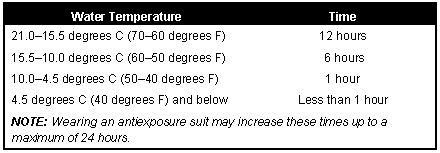Chapter 16
Sea Survival
THE OPEN SEA
COLD WEATHER CONSIDERATIONS
16-17. If you are in a cold climate—
Put on an antiexposure suit. If unavailable, put on any extra clothing available. Keep clothes loose and comfortable.
Take care not to snag the raft with shoes or sharp objects. Keep the repair kit where you can readily reach it.
Rig a windbreak, spray shield, and canopy.
Try to keep the floor of the raft dry. Cover it with canvas or cloth for insulation.
Huddle with others to keep warm, moving enough to keep the blood circulating. Spread an extra tarpaulin, sail, or parachute over the group.
Give extra rations, if available, to men suffering from exposure to cold.
16-18. The greatest threat you face when submerged in cold water is death due to hypothermia. The average ocean temperature around the world is only 11 degrees C (51 degrees F). However, do not be fooled by warm water—hypothermia can even occur in 27-degree C (80-degree F) water. When you are immersed in cold water, hypothermia occurs rapidly due to the decreased insulating quality of wet clothing and the result of water displacing the layer of still air that normally surrounds the body. The rate of heat exchange in water is about 25 times greater than it is in air of the same temperature. Figure 16-7 lists life expectancy times for immersion in water.
Figure 16-7. Life Expectancy Times for Immersion in Water
16-19. Your best protection against the effects of cold water is to get into the life raft, stay dry, and insulate your body from the cold surface of the bottom of the raft. If these actions are not possible, wearing an antiexposure suit will extend your life expectancy considerably. Remember, keep your head and neck out of the water and well insulated from the cold water's effects when the temperature is below 19 degrees C (66 degrees F). Wearing life preservers increases the predicted survival time as body position in the water increases the chance of survival.
Survival index
All text and images from the U.S. Army Field Manual 3-05.70: Survival.
Appearance of the materials from the U.S. Army Field Manual here does not constitute or represent endorsement by probablyhelpful.com.
ProbablyHelpful.com is not responsible for inaccurate or outdated information provided by the U.S. Army Field Manual 3-05.70.

